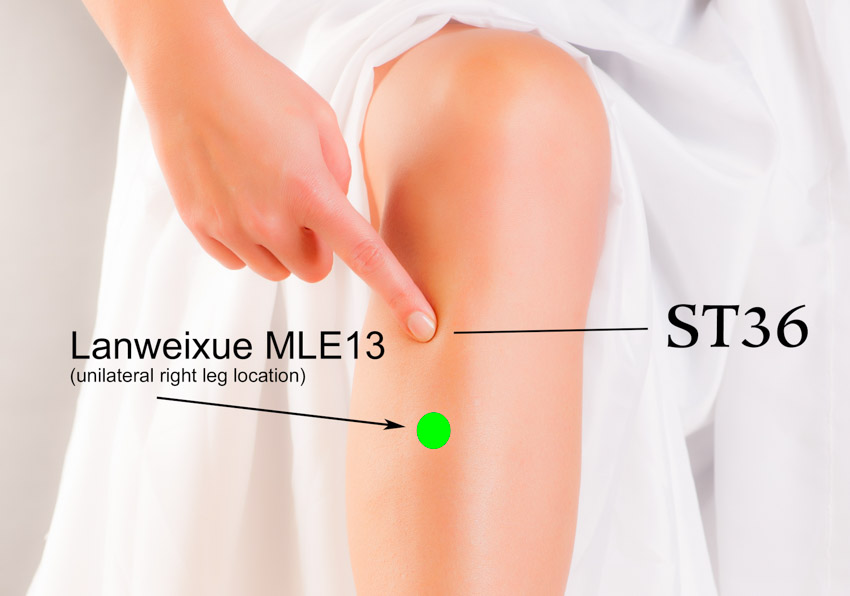
Acupuncture demonstrates acupoint specificity in stimulating the immune system to effectively respond to bacterial endotoxins. Harvard Medical School researchers in combination with researchers from Fudan University and China Academy of Medical Sciences have made an important discovery. The research team has identified the exact neurons that only specific acupuncture points stimulate to produce powerful anti-inflammatory effects.
Non-acupoints had no effect and specific true acupoints produced point specific effects. In addition, acupoints not traditionally indicated for reducing systemic inflammation did not reduce systemic inflammation. For example, acupoint BL56 (Chengjin) did not produce systemic anti-inflammatory effects in response to electroacupuncture stimulation. This is consistent with classical indications for BL56 for its use largely limited to treating local, foot, back and heel pain along with its special ability to treat hemorrhoids and swelling of the axilla in combination with BL40 (Weizhong) and SI5 (Yanggu).
PROKR2-Cre sensory neurons are responsible for the body’s ability to respond to electroacupuncture stimulation of acupuncture points ST36 (Zusanli) and LI0 (Zhousanli). The discovery is fascinating on two levels. First, never before has it been demonstrated that these sensory neurons are responsible for acupuncture’s ability to downregulate proinflammatory cytokines (TNF alpha, IL-6) and increase survival rates after exposure to bacterial endotoxins. [1] Second, ST36 and LI10 are classically paired acupoints in Chinese jing-luo medicine and now they are proven to promote similar physiological pathways, even though one acupoint is on the leg and the other on the arm. Both ST36 and LI10 reduced TNF alpha and IL-6 levels dependent on PROKR2 neurons. [2]
The researchers determined that high-intensity electroacupuncture at ST36 and LI10 activates the vagal-adrenal axis via PROKR2Cre sensory neurons. This produces a powerful systemic anti-inflammatory effect. Other acupoints not sharing densities of these neurons did not produce vagal-adrenal axis activation. The researchers note that “ST36 site can cause release of noradrenaline, adrenaline and dopamine from adrenal chromaffin cells that is dependent on the vagal nerve.” [3]They add that electroacupuncture at ST36 causes “a 50% reduction in TNF and IL-6 induction and a 40% increase in survival rates compared with sham ES [electroacupuncture stimulation].” [4]
Other acupoints demonstrated their own unique somatotopic correspondences and produced other physiological results. For example, ST25 (Tianshu) drives spinal sympathetic reflexes (not vagal reflexes) and requires higher levels of electroacupuncture stimulation to produce anti-inflammatory effects.
ST36 showed another important capability. Regular electroacupuncture stimulation produced anti-inflammatory effects via the vagal-adrenal axis and activation of PROKR2Cre sensory neurons. In addition, ST36 produces additional anti-inflammatory effects via spinal sympathetic reflexes at higher levels of electroacupuncture stimulation.
The researchers made another important discovery. Electroacupuncture stimulation wasn’t the only way ST36 produced significant physiological effects. Optical stimulation of ST36 increased serum noradenaline, adrenaline, and dopamine levels via PROKRS neurons and the vagal-adrenal axis. In addition, optical stimulation of ST36 produced a 50% reduction of TNF and IL-6 and a 50% increase in survival rates of bacterial endotoxin exposed laboratory rats.
The research team comments that optical stimulation at ST36 mimics electroacupuncture stimulation. The researchers note that, “Consistently, electrophysiological recordings in the left cervical vagal nerve showed a 15-fold increase in discharge rates in response to bilateral optical stimulation of the ST36 site.” [5] The researchers conclude that “optogenetic stimulation of PROKR2Cre- marked nerve terminals through the ST36 site is sufficient to drive the vagal–adrenal axis but not sympathetic reflexes.” [6] This is an important distinction in that the researchers determined that higher levels of electroacupuncture stimulation at ST36 drive sympathetic reflexes in addition to the vagal-adrenal axis.
The Harvard Medical School, Fudan University, and China Academy of Medical Sciences researchers note, “Our studies provide a neuroanatomical explanation for the presence of acupoint selectivity.” [7] They note that somatosensory autonomic reflexes at ST36 and LI10 suppress severe systemic inflammation. In addition, the somatotopic organization of ST36 and LI10 is through PROKR2 sensory neurons via the vagal-adrenal axis.
The research team also flags the importance of optogenetics. Optical stimulation at ST36 increased serum noradenaline, adrenaline, and dopamine levels and suppressed proinflammatory cytokines. At HealthCMi, we are encouraged by this type of investigation. In a separate investigation, researchers determined that optogenetics may promote restoration of neuronal function. Using engineered light emitting goggles in combination with an intraocular injection, researchers were able to restore partial vision in a patient with retinitis pigmentosa (RP). [8] Previously, the patient was completely blind. Based on the groundbreaking results, we would like to see greater attention paid to optogenetic stimulation research.
References
[1] Liu, Shenbin, Zhifu Wang, Yangshuai Su, Lu Qi, Wei Yang, Mingzhou Fu, Xianghong Jing, Yanqing Wang, and Qiufu Ma. "A neuroanatomical basis for electroacupuncture to drive the vagal–adrenal axis." Nature (2021): 1-5.
[2] Ibid.
[3] Ibid.
[4] Ibid.
[5] Ibid.
[6] Ibid.
[7] Ibid.
[8] Sahel, José-Alain, Elise Boulanger-Scemama, Chloé Pagot, Angelo Arleo, Francesco Galluppi, Joseph N. Martel, Simona Degli Esposti et al. "Partial recovery of visual function in a blind patient after optogenetic therapy." Nature Medicine (2021): 1-7.


